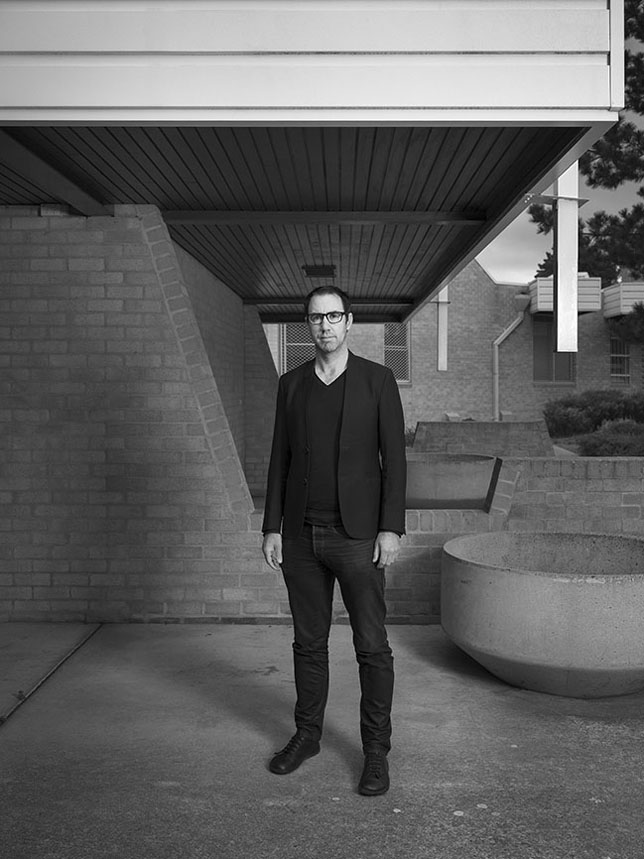As part of DESIGN Canberra’s celebration of the work of Enrico Taglietti, PhotoAccess (in partnership with DESIGN Canberra) commissioned Canberra photographer Mark Mohell to create a series of intimate portraits of people with strong connections to Taglietti and his design work. All photographs here are therefore by Mark Mohell, and are dated 2018.
In 1961, after some years in Canberra, Enrico Taglietti’s wife Franca and her family went back to Italy, intending to stay there; but they didn’t. Years later the architect’s wife told the Canberra Times that she realised Milan was no longer her place. ‘I enjoy the cosmopolitan atmosphere of Canberra … it’s a very interesting city’, she said.
Franca and Enrico Taglietti themselves contributed a great deal to the cosmopolisation and interest of Canberra, which is now scattered with remarkable buildings by the Milanese who, by way of Eritrea, and amazingly, drove onto the Limestone Plain in a Fiat 500 on a September afternoon in the 1950s and found the ‘dream of any modern architect’. Together, the ‘Taglietti people’ photographed by Mark Mohell express some of the traits of Canberrans that make life in the city interesting, too. Across generations, the geophysicist, the public servant, the artist, the builder, the developer and the architects share characteristics of unobtrusiveness, intelligence, curiosity and creativity.
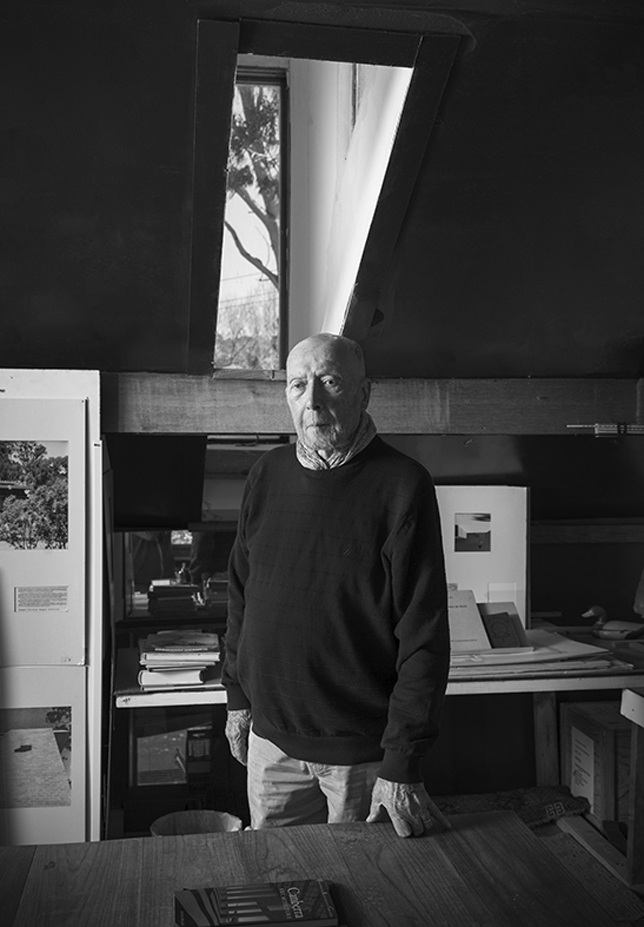
Darrel and Dinny Killen
Two Taglietti projects of the period 1961 to 1966 were realised right in the heart of the Griffins’ plan: Civic’s Town House Motor Inn and its associated restaurant, Noah’s Ark, both now ghosts; and the Center Cinema, which still stands although its interior has been traduced. Both were collaborations between the architect and the businessman Darrel Killen.
Darrel Killen didn’t fit the stereotype of a property developer. He grew up on the land north of Nyngan and attended a top school in Sydney before serving as a commando in New Guinea during World War 2. After studying at the University of Sydney he gained his master’s in philosophy at Oxford and went on to Chicago, where he obtained his doctorate in political science in 1954. He came to Canberra and began work as a research officer in the Prime Minister’s Department in 1955. That was a fateful year for the city, as a Senate committee brought down its report into the development of Canberra, listing the failures of successive Federal governments to see Canberra as a reality and to formulate clear strategies to complete the capital.[1] As a result, the National Capital Development Commission was established in early 1958. Henceforth the city’s future was assured. Excited by the potential for tourism, Darrel Killen left the public service to establish a motel company, initially called Moteliers.
Killen chose Taglietti to create the Town House Motor Inn in Canberra in 1961, and the Town House in Wagga Wagga, opened in 1963 when Moteliers was floated as a public company. Killen then engaged Taglietti to realise his dream of a plush modern cinema in which to show films that would now be categorised as ‘arthouse’, offering a sophisticated alternative to the city’s existing picture theatres. The Center Cinema — since described as ‘unbelievably luxurious — a temple to cinema, with state-of-the-art image and sound, everything in the best of taste and the height of luxury’ — opened in October 1966 with the Governor-General Lord Casey, lustrous international statesman of distinction, there on the night. Part of the complex was Charlie’s Restaurant, which remained a chic dining place into the 1980s. A contrast, though still pioneering and stylish in its way, Killen’s next cinema venture was the Sundown Drive-In in what is now Symonston. Taglietti designed an elegant low-lying café and amenities block for the drive-in. While the building now stands in the centre of a tourist park, traces of its lines and fit-out are still identifiable. Killen’s other cultural ventures included the Nova Cinema in Queanbeyan, opened in 1972; and the Boulevard Twin cinemas, opened at the end of 1973, which became Electric Shadows six years later.
Darrel and Dinny Killen, who married in 1960, had a property in the Majura Valley. In 1969 they commissioned a house for the block from Taglietti, who had built a house for Killen’s business partner, Ross Gibson, in Red Hill some years before. Among her other accomplishments, Dinny was the founding chair of the Australian Decorative and Fine Arts Society in Canberra. In 1988, under the guidance of the delightful CSIRO scientist, gourmet and vigneron Edgar Riek, she planted chardonnay, pinot noir, merlot and cabernet sauvignon grapes to establish the Mount Majura Vineyard. That year the Town House was demolished, and Darrel Killen donated to the National Gallery of Australia two panels of sculpture that Taglietti had commissioned from Clement Meadmore for its balconies in 1961.
In 1991, profiled in an article in the Canberra Times, the visionary Killen lamented the barriers to development in Canberra from the mid-1970s onward, advocated an increase in residential density around the town centres, and said ‘I think it’s time we looked at light rail. The National Capital Development Commission (NCDC) always took the view that it wouldn’t be workable until Canberra reached 500,000 population. We really should be studying it now.’
Darrel Killen died at the end of 2014.
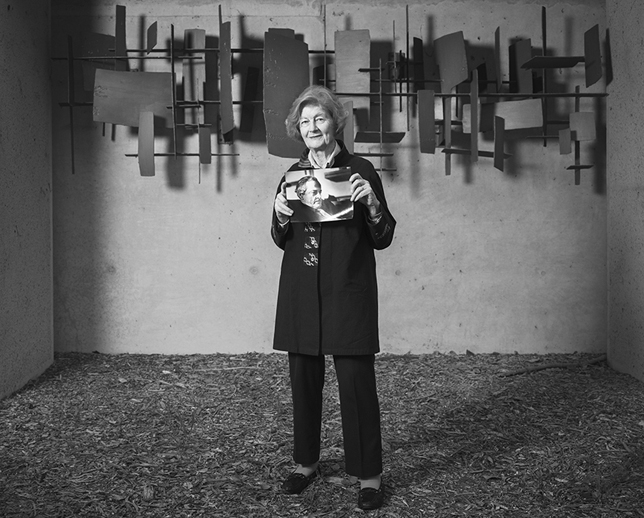
Mervyn Paterson
It used to be commonplace for outsiders to describe Canberra as ‘a big country town’; but it was never that, because of the nature of the people who populated it. By 1960 it was entirely accurate to describe a good proportion of its inhabitants as:
men of great skills, many of world repute, engaged in specialised research work as diverse as soils and public administration, geology and economics, oil discovery and anthropology, plant, animal and insect life and the mysteries of outer space, the secrets of the human body and of the sub-atomic world. (Rea 1960)
One such man, geophysicist and inventor Mervyn Paterson, came to the Australian National University in 1953. Like nearly all its foundation staff, he came recommended by top international researchers; and like most, he moved to Canberra without knowing anything much about the place. For about fifty years now, he’s lived in one of Taglietti’s great domestic buildings: the Paterson House.
Mervyn Paterson grew up on a wheat farm in South Australia, around Goyder’s Line, Booleroo Centre. As a very young boy, he had to get to school on the back of a neighbour’s horse. Later, at a one-room school in the Adelaide Hills, he had a teacher with a degree who introduced him to the possibility of academic study; he started university before he turned sixteen. On graduating as a metallurgist, he took a job at the CSIRO Division of Aeronautics at Fisherman’s Bend, where he investigated the failure of metal under fluctuating stress. In the late 1940s he completed his doctorate at the Cavendish laboratory in Cambridge — a Nobel hotbed — investigating what happened when he deformed copper at liquid nitrogen temperature. As a postdoctoral student at the University of Chicago, he lived in Holabird and Root’s Gothic nine-storey student residence, International House. It was less than ten minutes’ walk from Frank Lloyd Wright’s Robie House. At International House he met his future wife Katalin, a stateless Hungarian, daughter of a psychiatrist who’d trained either under Freud, or under someone who had. Katalin was completing her master’s in social service administration. In Chicago, Paterson had his first car — an Oldsmobile. He recalls that a few weeks after he and Katalin met, she dragged him to an exhibition of model houses. He couldn’t imagine why she’d want to go to it, but he drove her there, and while they looked at the houses she made one or two remarks that scared the life out of him.
When the new Australian National University (ANU) was forming — as a research-only institution — Paterson was recommended as a likely man to investigate rock deformation. Before long he and Katalin were living with their two children in Abbott Street, Yarralumla, where the university had three houses of modern design with bare wood floors and white walls. Paterson recalls that they had built-in flower boxes, and that when the same architect designed a building at the university, it had flower boxes too. While they were happy in the house, Katalin despaired not only of the primitivism of Australian social welfare infrastructure (degrees in social work were not introduced here until the 1940s), but also of the blandness of Australian food. To buy European groceries, she drove to Queanbeyan.
The head of the Geophysics school, John Jaeger, lived in Oaks House at Oaks Estate, an interesting, little-known house in the ACT region that the Patersons visited often. The university was so small that staff from the different schools mixed regularly with one other. Paterson and Bruce Benjamin, an Oxford-trained philosopher in the School of General Studies, shared an enthusiasm for cars; Paterson recalls that at different times Benjamin had a Delahaye and an Aston Martin. The Patersons were interested to see the evolution of the Benjamins’ Alex Jelinek-designed house in Deakin. When they spent a sabbatical at Cambridge, they were among the early inhabitants of Churchill College, a pioneer complex of English brutalism. On the family’s return from the UK, the Patersons starting thinking about buying a house of their own. They got a fair way with a good architect but couldn’t reach a compromise; he was committed to his vision of about twenty external doors. Katalin, who loved Italy and Italians (her mother’s cousin was married to Vittorio Cerruti, Italian Ambassador to China in the 1920s), went to see Taglietti. Paterson suggested she was shooting too high, but she wasn’t timid; she’d recently coordinated the two-year project of emptying the migrant camp at Benalla. Over 1968–1969 Taglietti designed the forceful house that looms at the end of Juad Place, Aranda.
While living in the Abbott Street house, the Patersons had enjoyed its northwest aspect. They told Taglietti so, and he positioned a patio at that orientation opening from the living room. The focal point of the space is a healthy lemon tree whose bright orbs glow into the indoor sitting area. The patio gives onto the bush, and an occasional echidna trundles in. Paterson and his daughter Elizabeth recall that as the house was under construction, and the verandah wall was being built, they took turns sitting in the future dining room, directing the addition of successive courses of brick until neighbouring houses were obscured and the view was only sky (now, it’s treetops).
Over the course of his experimental career, Paterson made his own apparatus to deform rocks in the Geophysics workshop at ANU, assisted by superb craftsmen on staff. Around the time he retired he began to make the equipment commercially, and saw his machines installed in labs around the world. Although he was still walking to work at ANU in 2006, at various times he owned several Rileys, a Rolls Royce, a Daimler and a considerable number of Minis, and in his time away from the lab he worked on his cars himself under the house, where he also had a box room, workshop and cellar.
In 1953, with the aforementioned Edgar Riek, Paterson was a founding member of the Canberra Wine and Food Club, discreetly situated in an unobtrusive building in the city’s inner south. He was still a member in 2018. In its early days, club members used to order barrels of wine from Rutherglen and decant them into recycled bottles for distribution. Meanwhile, Katalin joined the University Wives’ Cooking Club, meeting regularly with women with international connections including Gun Ringwood and Rosemary Brissenden, whose didactic South East Asian Food was first published in 1970. (Interest in international foods was widespread in Canberra. In 1961, for example, Franca Taglietti joined diplomatic wives in a series of cookery classes for the YWCA; she demonstrated how to make pizza.) Katalin dictated the kitchen layout in the Paterson House, with stove and benches positioned so she wasn’t cut off from others as she cooked, and she faced the stupendous views. Strikingly, the downstairs laundry is commodious and full of light, with a large shelf for processing washing, ample room for ironing board and baskets, built-in cupboards finished to the same standard as those in the bedrooms, and views out to the bush through windows and door. (The bathroom also has a view.) Katalin loved the house and sat still in its sheltered spots, the wrens and parrots her companions during her last illness.
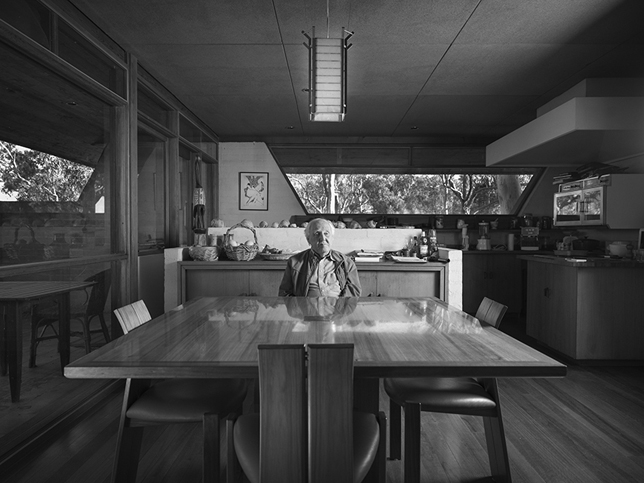
Judi Elliott and Robert Worley
Like Darrel Killen, Robert Worley came to Canberra in 1955; but he came from Brisbane on a motorbike. Within a month he’d bought a car, and soon he moved into Mulwala Hostel behind the Catholic Archbishop’s house, near the new Olympic Pool. Canberra struck the young man as a jumping place, with lots of interesting cars that had been shipped out by embassies or returned with staff after overseas postings: four-door Buick convertibles, Peugeots, Citroens, Mercedes, the odd Delage and Chevy Bel Air. Worley worked for decades in the public service, while developing his interests in film and literature and becoming involved with the Repertory Society — where he met quite a few people who had taken to amateur theatricals in Foreign Affairs — and Canberra Philharmonic. In retirement he spent 28 happy years as a guide at the National Gallery.
Worley’s interest in architecture dates from his teens, when he worked at a Brisbane advertising agency and wrote away for a subscription to American House and Garden magazine. He knew of Taglietti’s successive projects in the ACT, but it was his passion for cars that led to the men’s first meeting. At the time, the architect was driving a Lancia Sport Zagato, and Worley owned a Lancia, too. Spotting the elegant Italian in Manuka, Worley introduced himself and they chatted about their rare birds for a few lively minutes. Worley has owned more than seventy cars. Asked which he most regrets letting go, he speaks lovingly of a certain Mercedes SLK sports roadster, but quickly concedes that he still feels the loss of any one of two to three dozen of them.
When Worley started seeing Judi Elliott, he lived in a Willemsen town house in Holder, and she lived out on the Widgiewa Road, east of Canberra, in a house made of convict-built bricks from one of Goulburn’s several demolished courthouses (some had fingerprints in them; some were stamped with a rabbit’s foot). Elliott, originally a ceramicist, exhibited regularly with Beaver Galleries from 1975. In the mid-1980s she was one of the first graduates in glass at the Canberra School of Art, and in 1988 she studied at the Pilchuck Glass School — founded by Dale Chihuly — near Seattle. Now she has works in public galleries in Australia and abroad, and her major private commissions include four floors of large-scale panels for the Commonwealth Bank, Brisbane; a huge piece for the Mercantile Mutual building in Darling Harbour; and many panels for professionals’ rooms in London. For some years she’s been casting her brilliantly coloured forms in a studio attached to the ‘Mijuscovic House’ in Sullivan Crescent, Wanniassa, where she and Worley have lived since 1998.
Elliott, originally from Cootamundra, had never lived in a suburban house before the couple started looking for one. She didn’t know Taglietti’s style, but Worley knew where his houses were. They heard that the house in Downes Place was on the market, but they couldn’t seem to persuade the agent to let them in. At the same time a Robin Boyd house was for sale, but when they looked at it, it reminded them of Escher’s drawings. One Saturday Elliott, still living out on the property, got hold of the Canberra Times and saw an advertisement for a house that was ‘not for the Brady Bunch’. She rang Worley immediately and they contacted the agent, but someone was already interested. As it transpired, their rival for the house had a heart attack on the Sunday or Monday. They saw it on the Tuesday and didn’t even inspect the whole place (which isn’t large) before they told the agent they’d take it — even offering to pay more than the asking price. Later, the vendor asked them if he could buy it back. They declined to sell.
Elliott and Worley hadn’t made a date to marry, but once they moved into the house they decided they’d be wed there without delay. They only invited a celebrant and two witnesses, but to their astonishment, as the service concluded many of their friends came in with food. They’d bought their enormous table just the day before, and there it was, laid with a wedding breakfast. It was the first of countless dinners at the table: good times in a space hung with fine art and textiles, remarkable for its atmosphere of tranquillity. For the visitor, the view of the surrounding country from the small park across the road from the house is spectacular, but the sight of the same country from inside the house is downright astounding. Worley remarks that visitors come in and say ‘wow, look at the view’, but the art of the architect lies in positioning the house on the block, evaluating the vistas, choosing and devising the way they’ll be framed to become part of the living space. Not long after the couple moved in, a violent storm hit Wanniassa. They sat on the stairs in their living room at 3am, gazing upon an awesome spectacle out their huge front windows. As the wind lashed the trees around and the lightning flared, they felt the protection of the home they’d found together.
After they bought the house, Elliott and Worley went to Taglietti’s office in Durville Crescent and introduced themselves, initiating a friendship. A bust of Taglietti occupies their living room like a quiet friend. The bust is a Canberra story in itself: it was made by Camilla de Martino, a well-known European sculptor, whose husband was the Italian ambassador in Canberra from 2010 to 2014. As for Elliott’s eyrie workshop, it’s the former garage. Worley had liked the garage very much. At first, Elliott worked downstairs, which was not ideal. They consulted Taglietti about her accommodation, and he drew up plans for a studio on the side of the house. However, when he brought a fellow architect to see the site, Worley was disconcerted to see them standing in the garage, gesturing around the space, talking rapidly in Italian. Sure enough, the architects declared that the very spot on which they stood was the only possible place on the block for an artist to work. The garage was duly converted. Happily, a neighbour who’d been through some domestic change had some garage space; she let Worley work on his cars in there.
For gentle Judi Elliott, attuned to form, living in the house is like living in a sculpture. For his part, Bob Worley speaks with some emotion and wonder of a ‘conscious experience of achievement’ coming from living in the house, explaining it as best he can as a ‘major step for a boy from Queensland’. As a Taglietti creation he feels it excels in expressing the architect’s lifetime of experience. He still can’t believe it’s where they live.
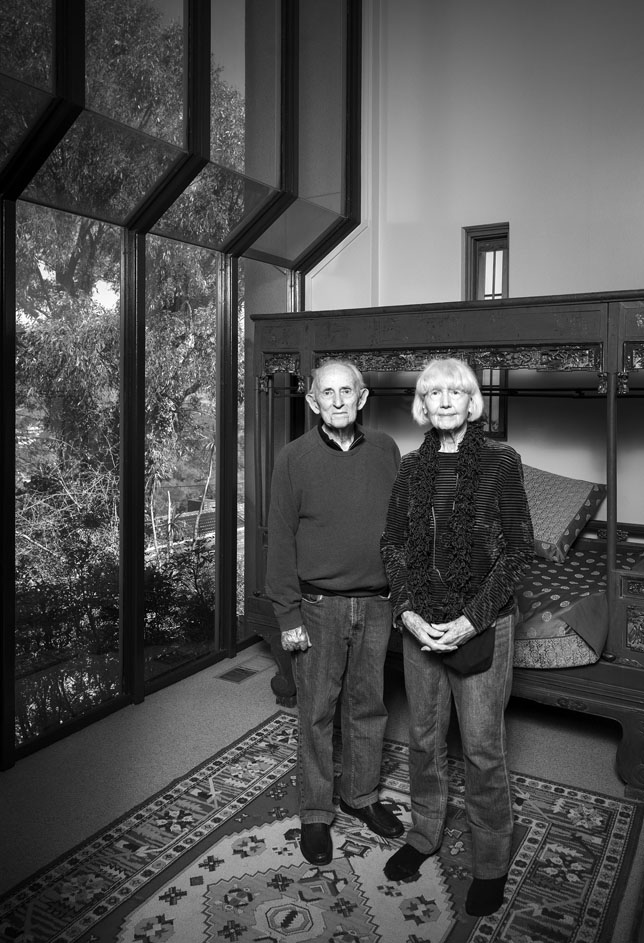
Suzie Northcott
Suzie Northcott and her son Luis Goldacre live in the ‘Dingle House’ in Downes Place, Hughes, commissioned from Taglietti by career diplomat Anthony Dingle and his wife Diana in the mid-1960s. Northcott’s interest in Modernist architecture formed alongside that of her late husband, Phil Goldacre, a remarkable man of parts, who came to it by way of his early love of engines. Born in the mid-1950s, he grew up in Meehan Gardens, Narrabundah, and attended Narrabundah High before taking up an apprenticeship with Corin Motors, dealers in Renaults and Peugeots. Devoted all his life to Ducatis, and particularly the designs of Fabio Taglioni, he completed half an apprenticeship in fitting and turning, too, so he could refine and re-make components in titanium and aluminium. His admiration for Taglioni led him to the furniture designer Gio Ponti – like Taglietti, a Milanese, and one of the architect’s teachers. Goldacre came from a line of furniture makers on both sides, and in the late 1980s he undertook another apprenticeship, in carpentry this time. In the early 1990s he began working full-time at Parliament House, and at the same time completed the Graduate Diploma in Wood at the ANU School of Art. He drove a Peugeot ute, but all his life he was mad about Italian style — from his Ducati, which he could often be found finessing in his garage, to his Sorrentina coffee maker in the kitchen.
Suzie Northcott grew up in Torrens, founded in 1966 in the Canberra satellite of Woden Valley. Many interesting houses were built in Torrens in the late 1960s and 1970s and, as was customary for Canberra children, Suzie and her friends used to play in the half-built dwellings on the weekends. She and Goldacre married in 1987. In her thirties, she gained a Harkness Fellowship to complete her master’s degree in health economics at Harvard; the couple moved to the USA in 1995. During their time in Cambridge they took the opportunity to explore Modernist architecture and design, including the Gropius House in Lincoln Massachusetts, Eero Saarinen’s Chapel at MIT and Corbusier’s only building in North America, the Carpenter Centre for the Visual Arts at Harvard. Goldacre had been hoping to audit classes at the Harvard Design School, but they proved too costly, so instead he volunteered as a technical assistant to Professor Kimo Griggs, making furniture. While they were away, Northcott also had a research stint in health economics in Seattle.
Harkness Fellows are required to undertake three months’ travel in the USA to better understand America and Americans. Nothing loath, after her year at the Kennedy School Northcott and Goldacre hit the road in a ‘Brady Bunch’ car. Wood-veneer-panelled, velour-upholstered and air-conditioned, it was a contrast with the leaky old Peugeot they’d left in Canberra. On an indirect route from Cambridge to Seattle they saw definitive buildings by Frank Lloyd Wright, Walter Gropius and Mies van der Rohe; in Los Angeles they saw Wright’s Hollyhock house and got to know the designs of Richard Neutra.
When the couple returned to Canberra they lived in Novar Street, Yarralumla. Sometimes they’d visit friends in Hughes and finish up walking home past the Taglietti house backing onto the Red Hill reserve. On a Tuesday in 1998, about six months after the birth of the couple’s son Luis, Goldacre headed down to Manuka for a gelato. In Thetis Court, he saw the Dingle house advertised in an estate agent’s window. On the Wednesday, they bundled Luis up, went to see it and offered to buy it. The agent was keen for the owners to hold off until it was first advertised in the paper, on the Saturday; but the owners, having raised their own children in the house, were drawn to the trio. Pleased with the idea that the house would pass to people who appreciated its design context, they sold.
At Parliament House Goldacre was responsible for a range of unique pieces of furniture for Prime Minister Keating’s suite, as well as two of the ‘boat’ tables in the committee rooms. As he worked, he realised that very little of the one-off commissioned furniture in the Parliament had been documented, and the perceived significance of the building’s superb contents was likely to diminish progressively. He spent several years documenting each object and its location before leaving Parliament House in 2007 to establish his own furniture practice. His own fine pieces are in private homes across Canberra and Australia, including the Dingle House; but his independent career was cut short by his death from cancer in 2010.
The house in Downes Place was more than thirty years old when the family moved in. Northcott and Goldacre replaced the original particle-board kitchen and reworked the bathroom in predictably sympathetic style. While not a large house by modern standards, its design now allows her and Luis their respective private areas. Airy and orderly in itself, it’s also home to works of art of very serious quality, many by the couple’s friends, but it’s not museum-like. Northcott doesn’t feel precious about any of it, or afraid she’s going to degrade anything day by day. She does acknowledge a degree of consciousness of her responsibility as a custodian of ‘a Taglietti’; she’s had to get used to people asking to photograph it for design publications and showing students and scholars through it. Yet she recalls fantastic parties there, guests clustered and scattered between the deck, the fireplace in the mezzanine living area, the dining below and the kitchen on another level again, every area giving a different perspective on the surrounding garden, trees and grassland. Solid, yet full of light, it is a house that seems to resonate with the conversations and debates, the profound human junctures and emotions experienced under its graceful roof.
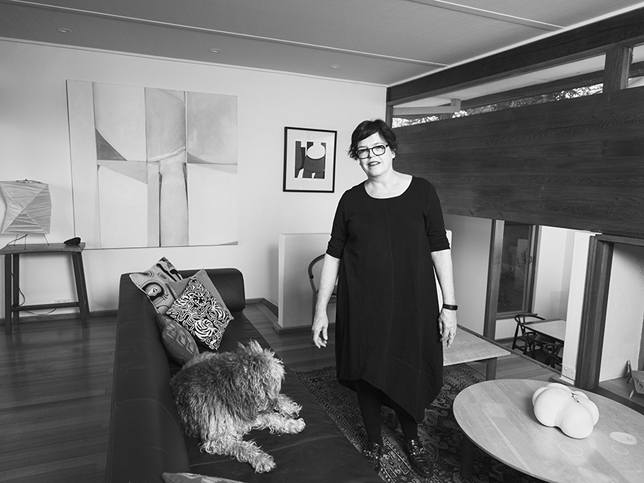
Bob Beaver
A number of Taglietti’s surviving public buildings, including the Dickson Library and the Giralang Primary School, were commissioned by the NCDC. (Both of those buildings, incidentally, lie in what Taglietti would regard as the ACT — not in Canberra, which he limits more or less to the area covered by the Kurrajong electorate.) Maintaining that ‘without the NCDC there would be no Canberra’, Taglietti speaks very favourably of his NCDC projects, recalling that their scope and nature were very clear, the terms were unambiguous, his responsibilities were defined and the commission’s staff not only dealt with him honestly, but paid on schedule. He describes men such as John Overall and Tony Powell as ‘professional’. It may be inferred that they saw him that way in return. Giralang Primary School was completed at the end of 1976 and the Canberra Times reported the NCDC was happy both with its cost, which came in on budget at $1.85 million, and with its innovative qualities. Replete with alternating small and large spaces, nooks, courtyards, cathedral ceilings juxtaposed with flat roofs, changing levels, curves and portholes and set in landscaped surrounds, it had a hall that could be closed off for weekend use by community groups, and shortly after classes began in 1977 it was reported that there were twenty-five nationalities represented in the school. Soon it had an active P&C,[2] which put out a newsletter called ‘The Giralanger’, and convened an Ethnic Night in the winter of 1979.
Bob Beaver’s long association with Enrico Taglietti began in the 1970s. Beaver’s family has deep roots in the Canberra region; his mother was born at Ginninderra School House. He grew up in Queanbeyan and lived there until a few years ago, when he and his wife Helen moved to Deakin. As a lad he had a good time playing football, swimming and working in his family’s market garden before he became the very embodiment of the familiar observation that ‘Queanbeyan built Canberra’.
Beaver went straight from school into the building industry, completing some courses through the Canberra Institute of Technology (CIT) and some by correspondence through the Sydney-based Nangle Institute of Technology in the 1950s. In 1957 he began working for Monier; three years later he left to work on the Canberra Hospital at Acton, remaining on the ‘peninsula’ through the many phases of construction before completion in 1964. On his next landmark project, the National Library, he was one of two quantity surveyors responsible for estimating the amount and cost of all materials and labour involved in the build. Although he concedes there were stresses associated with the job — as may well be imagined — it was a convivial atmosphere on site. About a hundred of the men who built the hospital had come over to the library, and in the afternoons it was their habit to go over to the Hotel Canberra (now the Hyatt) and tell a few stories. Many of them lived at the Hillside hostel on Capital Hill, its proximity to both sites a boon because, Beaver recalls, after more than one celebratory evening they had to be routed out of their beds to come to work.
In 1974, having worked with ACT Builders for a few years, Beaver set up his own company, Beasec Enterprises, in partnership with a friend. Beasec handled the construction of a host of public facilities including schools, churches, pavilions, chapels and health centres in Canberra and Queanbeyan through the 1970s, 1980s and 1990s. Some of Beaver’s favourite and most interesting jobs were conducted with Taglietti. One was the Nitrate Film Vaults, the repository for Australia’s irreplaceable early moving pictures in Mitchell, ACT. Film made from cellulose nitrate gives off gas and can self-combust; once alight, it burns very fiercely, resisting attempts to extinguish it. Until the vaults were built in the ACT, Australia’s film treasures had been subjected to a number of ignominious relocations to hazardous, makeshift quarters. The facility was designed to minimise the chance of the material catching fire in the first place, and also to contain damage should anything ignite. To these ends, Taglietti designed a series of underground chambers, humidity and temperature-controlled, separated by steel doors, vented by chimneys poking through the ground high into the air above. Comparing the structure to a jail with no windows — with finite amounts of material confined to each ‘cell’ — Beaver characterises the Nitrate Film Vaults as a relatively small-scale job, but a very challenging one. Yet on this project, as on others, the builder found the architect very approachable and willing to work through any practical problems that arose, often by constructing a physical model.
Bob Beaver was the man who oversaw construction of Taglietti’s visionary Giralang Primary School, too. That was a large project, and one in which all the employees got to know the architect. One of the aspects of the job that pleased Beaver most was that everyone involved learned something from it. In calculating the cost of the project, Beaver had to take into account the complexity of the bricklaying; as a rule, he had enough trouble getting the boys to lay the bricks straight, and now he had to support them through the very tricky and slow business of the placing of the bricks in curves and around slits and circular windows. Nonetheless, if he said to Taglietti ‘You drew it — you show me how to make it’, the architect would set to then and there, sketching almost brick by brick, before telling him that he could do it another way if he liked as long as it ended up looking as it did on the architectural drawings and was structurally sound. In keeping with the joyous design of the school, Beaver recalls that it was a happy project, through which everyone remained friends. As a kind of tribute, when he built his own house at Weetalabah Estate he included a pair of aligned circular windows, one at each end of the house. Later, when he and Taglietti worked together to realise the Saudi ambassador’s residence, there was a great deal of interior detail to consider, both in the building and its fit-out and furnishings. Beasec had its own joinery division, and Taglietti turned his designs for unique furniture for the residence over to one old woodworker who loved to complain about the pieces, but also loved to make them. Although Beaver remarks wryly that during various jobs he doesn’t know who lost more hair — him or Enrico — he never lost money on a Taglietti project, because they were always well planned (he observes that while many clients believe the cliché that builders make money through variations, builders just as often lose money when plans are altered). He found it a great advantage to be working with the principal architect all the time, as decisions were instant and the job ‘simply flowed’.
Beaver recalls the glamour and charm of Taglietti and Franca and speaks with affection of the many Italians with whom he’s worked over decades. Vehicularly, however, he’s a Holden man, his ownership history including two V8 Statesmans he fitted with extra water tanks as they’re notorious for boiling. A few years ago one of Beaver’s apprentices came to him and told him that he was leaving. The boss asked why and the ‘apprentice’ replied that after 42 years with the business he felt it was time to retire. It encouraged Beaver to think about his next phase, too. He still has premises in Bayldon Road, Queanbeyan, and is in the office on Wednesdays; he’s taken very keenly to digital technology. He has a property at the coast near Batehaven, where he exercises his passions for gardening and breeding show poultry (he is a judge of birds). He has a turbo Mercedes, but maintains a V8 Holden ute from 1996 that he prefers to take to the coast; compared to his town car, he finds it fairly flies up the Clyde.

Dave Pigram
Dave Pigram, whom Mohell also photographed at Giralang Primary School, is currently a Course Director at the University of Technology, Sydney and a global leader in the exploration of the application of robotics and digital design in architecture. Still a young man, he’s also taught at Columbia University and the Pratt Institute in New York; the Architectural Association in London; Princeton University in New Jersey; the University of Michigan; the Aalborg School of Architecture in Denmark; the University of Canberra; and the Institute for Advanced Architecture of Catalonia (IAAC), Barcelona.
Pigram attended Giralang Primary School from 1984 and credits the experience as a major influence on his choice of career. (His long-term girlfriend, also an architect, went to a Taglietti school too — in Flynn.) Pigram’s early memories are imbued with the magic of the building and its grounds. He recalls a teacher telling the infants that ‘Gypsies occupied the school, and that one day, when alarmed, they threw their crystal balls so high in the air that the balls caught on spikes in the ceiling, creating the pendant lights’. He has sense memories of the building’s changing levels, the roof coming close and moving away and places where students could ‘hide’, recalling especially a grand day when he and his friends found a pretext to slip into a manhole and explore beneath the floor. Now, he speaks of the ‘world’ of Taglietti, in which everything was up for reinterpretation: how he invented a ‘calligraphy’ of how you draw a wall, how you catch water. He speaks of the architect’s ‘moves’, encompassing solar gain, shelter, subdivision of space, strategies for his structures to both sit in the environment and capture its views from the interior. If a school can be so reinvented, Pigram believes, anything can, and he’s delighted by the idea that Canberra’s bureaucrats went so far as to employ great architects to design some children’s facilities, instead of deeming even a few curves, fillets and flourishes a waste of money. It’s telling that Pigram’s own great passion, now, is libraries; and that he constantly tries to see each element afresh, regarding roofs, for example, not just as coverings, but as means to define spaces.
In Pigram’s experience, an architect most loves the buildings around which the client went with them on the journey. Good clients get good results, he asserts. For a Canberran, it’s a matter of pride that Taglietti’s clients, both domestic and government, were good ones.
Pigram observes that Taglietti ‘did a great job to lock in here and give to Canberra’, as it’s the fate of some architects merely to ‘increase the private privilege of already privileged people’s lives’. Instead, one of Canberra’s sentient, diffident and constant champions, Taglietti ennobled us through gifts of his own design.
